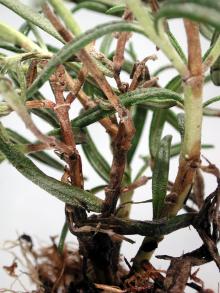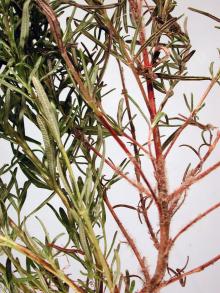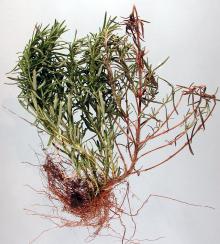See:
Greenhouse Plants, Ornamental - Gray Mold
Cause Botrytis cinerea, fungi that colonize dead, dying, and wounded plant parts. From these infections these fungi can attack healthy tissues. A moist, humid environment is ideal for pathogen sporulation and spread. The disease has been found several times by the OSU Plant Clinic.
Symptoms Necrosis that expands up and down stems. Portions above cankers wilt, die, and collapse when girdled. Defoliation also occurs. Root systems remain healthy.
Cultural control
- Good drainage is essential in pots or the landscape.
- Water and fertilize lightly.
- Remove all dead and dying plant parts on and around plants and take them out of the greenhouse. Many growers use closed containers to minimize the amount of conidia.
- Maintain a steady, relatively dry environment by keeping greenhouse humidity below 90%, increasing spacing between plants for good air circulation, and taking care not to splash water on foliage during watering.
- Place fans in greenhouse to get better air circulation.
Chemical control Focus on cultural-management tactics first.
- Palladium at 4 to 6 oz/100 gal for use in the greenhouse. Group 9 + 12 fungicide. 12-hr reentry.
- Switch 62.5 WG at 11 to 14 oz/A. Do not apply within 7 days of harvest. Group 9 + 12 fungicide. 12-hr reentry.
Reference Fillinger, S., and Elad, Y. (eds.). 2016. Botrytis-the Fungus, the Pathogen and Its Management in Agricultural Systems. Switzerland: Springer International Publishing




